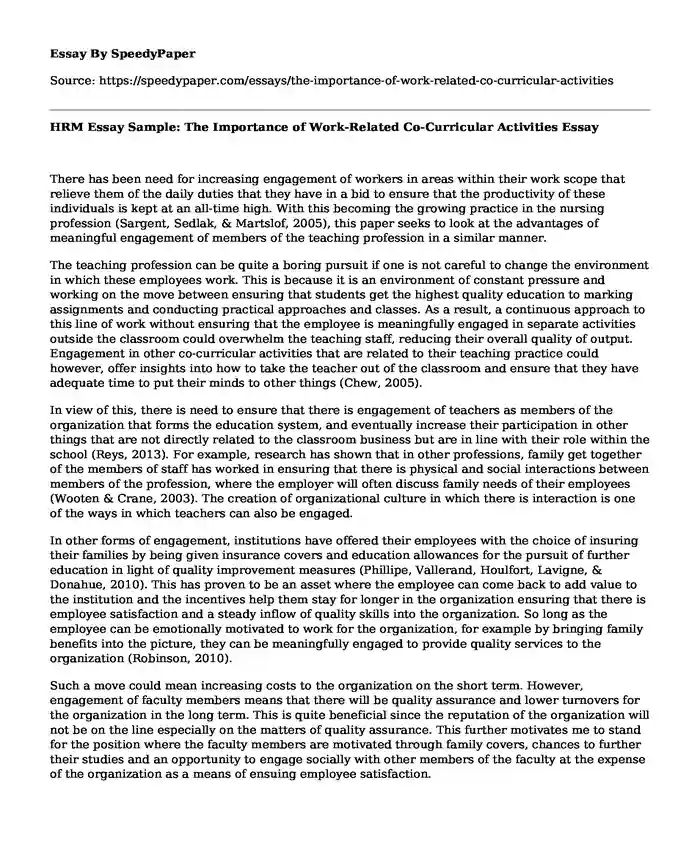
| Type of paper: | Essay |
| Categories: | Management Human resources Social activities |
| Pages: | 3 |
| Wordcount: | 683 words |
There has been need for increasing engagement of workers in areas within their work scope that relieve them of the daily duties that they have in a bid to ensure that the productivity of these individuals is kept at an all-time high. With this becoming the growing practice in the nursing profession (Sargent, Sedlak, & Martslof, 2005), this paper seeks to look at the advantages of meaningful engagement of members of the teaching profession in a similar manner.
The teaching profession can be quite a boring pursuit if one is not careful to change the environment in which these employees work. This is because it is an environment of constant pressure and working on the move between ensuring that students get the highest quality education to marking assignments and conducting practical approaches and classes. As a result, a continuous approach to this line of work without ensuring that the employee is meaningfully engaged in separate activities outside the classroom could overwhelm the teaching staff, reducing their overall quality of output. Engagement in other co-curricular activities that are related to their teaching practice could however, offer insights into how to take the teacher out of the classroom and ensure that they have adequate time to put their minds to other things (Chew, 2005).
In view of this, there is need to ensure that there is engagement of teachers as members of the organization that forms the education system, and eventually increase their participation in other things that are not directly related to the classroom business but are in line with their role within the school (Reys, 2013). For example, research has shown that in other professions, family get together of the members of staff has worked in ensuring that there is physical and social interactions between members of the profession, where the employer will often discuss family needs of their employees (Wooten & Crane, 2003). The creation of organizational culture in which there is interaction is one of the ways in which teachers can also be engaged.
In other forms of engagement, institutions have offered their employees with the choice of insuring their families by being given insurance covers and education allowances for the pursuit of further education in light of quality improvement measures (Phillipe, Vallerand, Houlfort, Lavigne, & Donahue, 2010). This has proven to be an asset where the employee can come back to add value to the institution and the incentives help them stay for longer in the organization ensuring that there is employee satisfaction and a steady inflow of quality skills into the organization. So long as the employee can be emotionally motivated to work for the organization, for example by bringing family benefits into the picture, they can be meaningfully engaged to provide quality services to the organization (Robinson, 2010).
Such a move could mean increasing costs to the organization on the short term. However, engagement of faculty members means that there will be quality assurance and lower turnovers for the organization in the long term. This is quite beneficial since the reputation of the organization will not be on the line especially on the matters of quality assurance. This further motivates me to stand for the position where the faculty members are motivated through family covers, chances to further their studies and an opportunity to engage socially with other members of the faculty at the expense of the organization as a means of ensuing employee satisfaction.
References
Chew, T. (2005). Achieving organizational prosperity through employee motivation and retention: a comparative study of practices in Malaysian institutions. Research and Practice in Human Resource Management, 13(2), 87-104.
Phillipe, F., Vallerand, R., Houlfort, N., Lavigne, G., & Donahue, E. (2010). Passion for an activity and quality interpersonal relationships: the mediating role of emotions. Journal of Personality and Social Psychology, 917-32.
Reys, R. (2013). Getting evidence-based teaching practices into mathematics departments. Notices of the AMS, 906-10.
Robinson, C. (2010). The keys to turbo-charging intrinsic motivation. Journal for Quality and Participation, 4-8.
Sargent, S., Sedlak, C., & Martslof, D. (2005). Cultural competence among nursing students and faculty. Nurse Education Today.
Wooten, L., & Crane, P. (2003). Nurses as implementers of organizational culture. Nursing Economics.
Cite this page
HRM Essay Sample: The Importance of Work-Related Co-Curricular Activities. (2020, Apr 27). Retrieved from https://speedypaper.com/essays/the-importance-of-work-related-co-curricular-activities
Request Removal
If you are the original author of this essay and no longer wish to have it published on the SpeedyPaper website, please click below to request its removal:
- Literary Essay Example on Killings by Andre Dubus
- Healthy lifestyle
- Games and History, Free Essay Sample
- Bases of Power: Expert Power - Essay Sample
- Critical Essay on How the Other Half Lives by Jacob Riis
- German Expressionism and Editing Meanings in Alfred Hitchcock's Psycho and The Birds: Essay Sample
- Developing Technologies for Enhancing Ethical Procurement in Supply Chains - Paper Example
Popular categories




